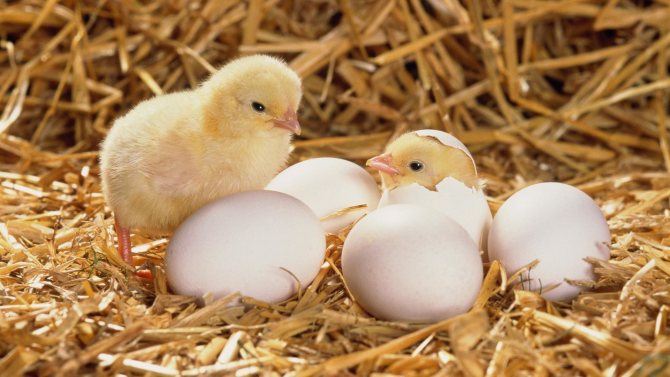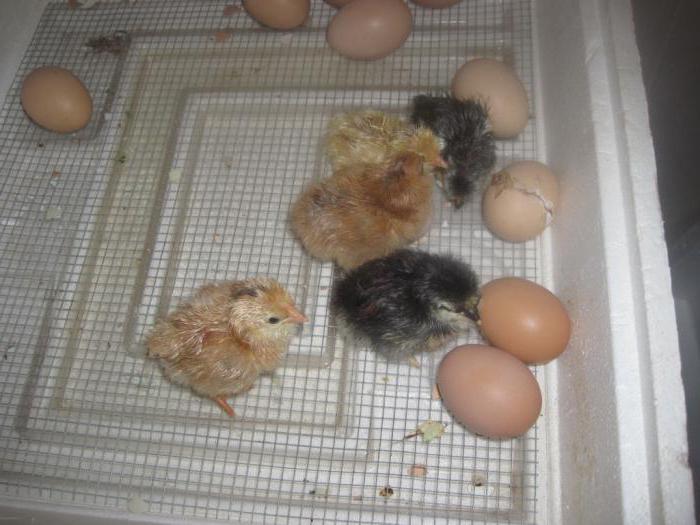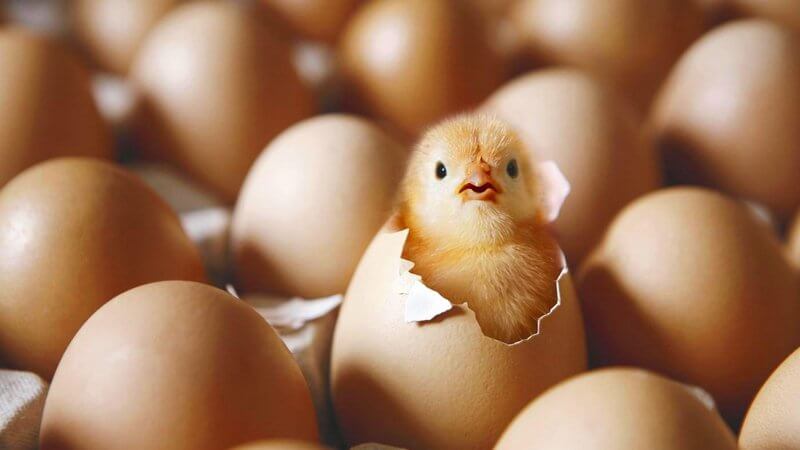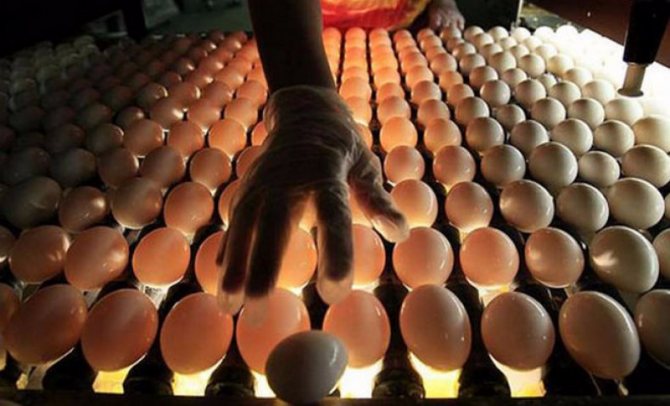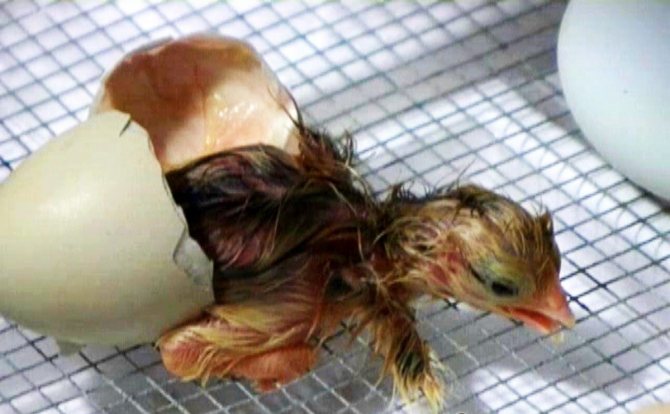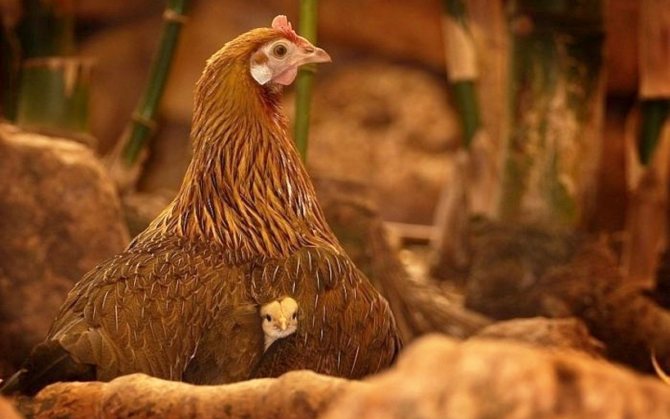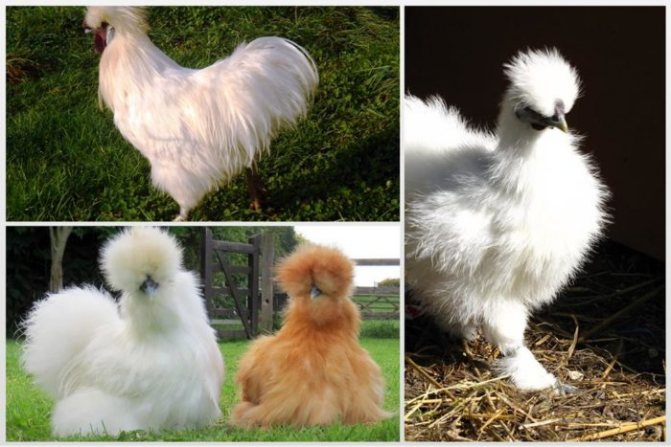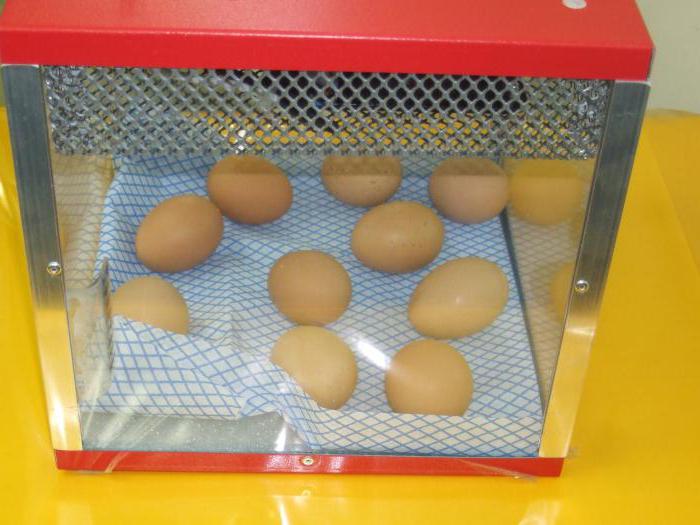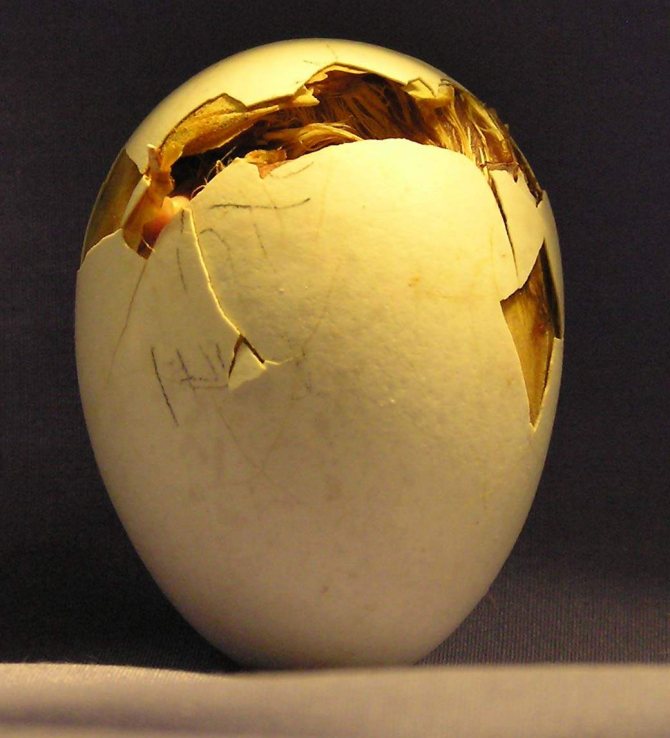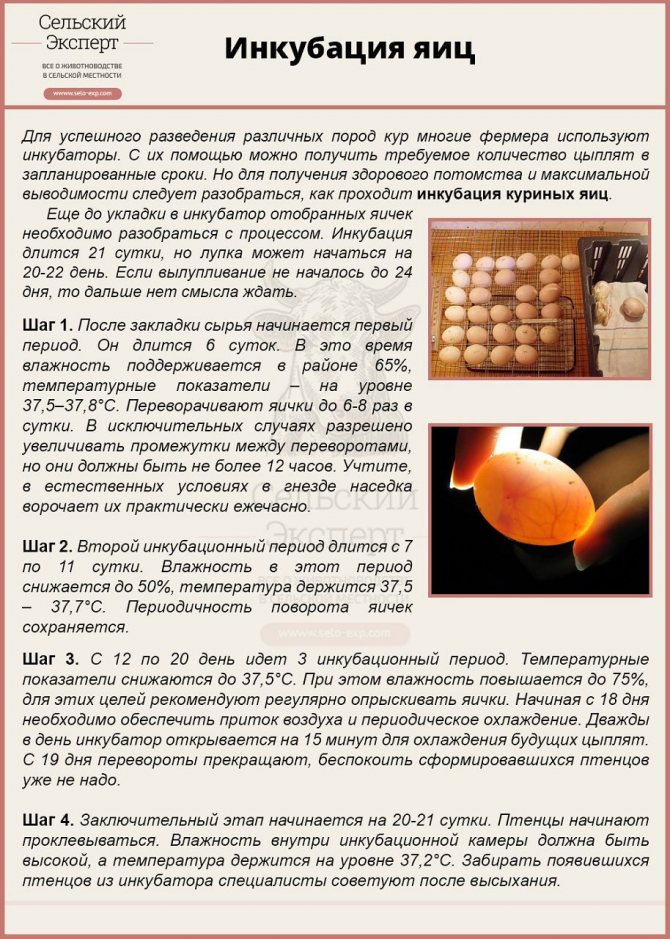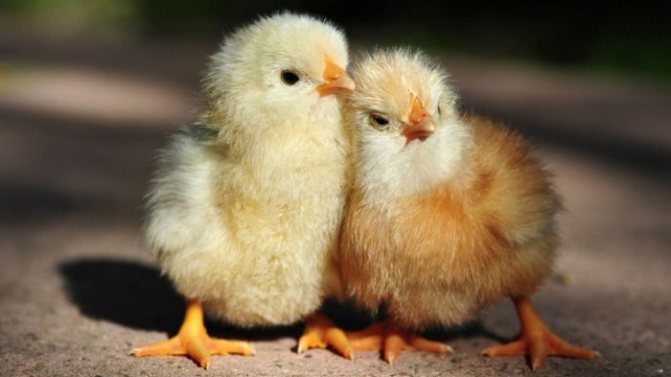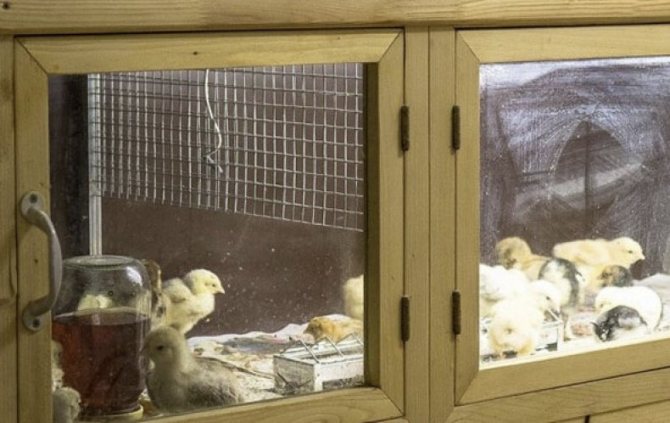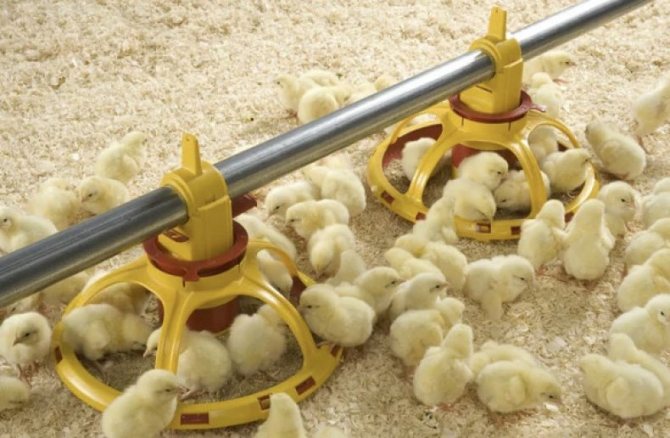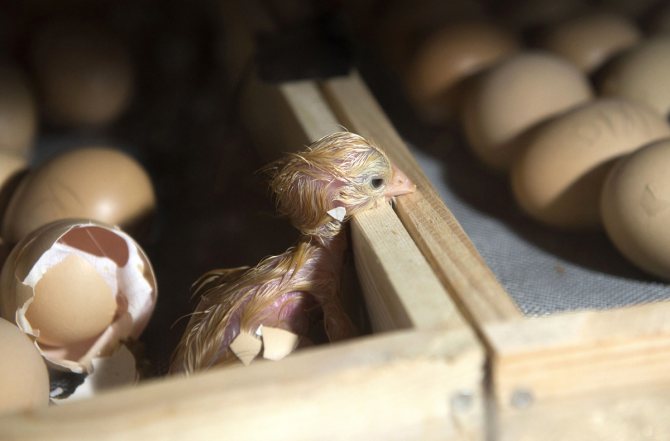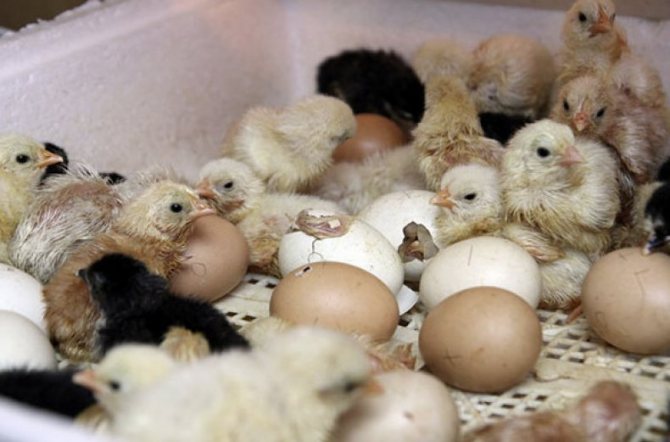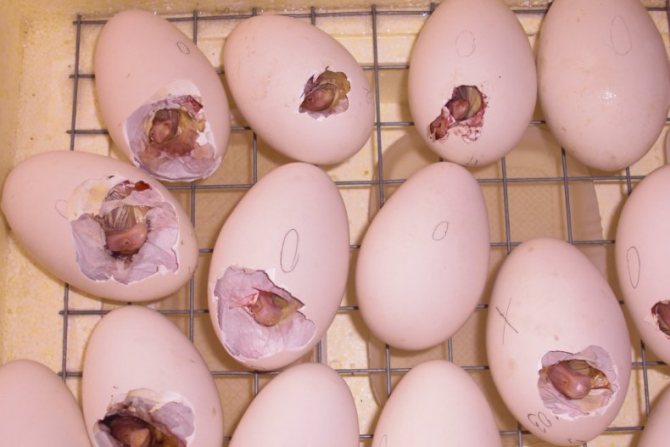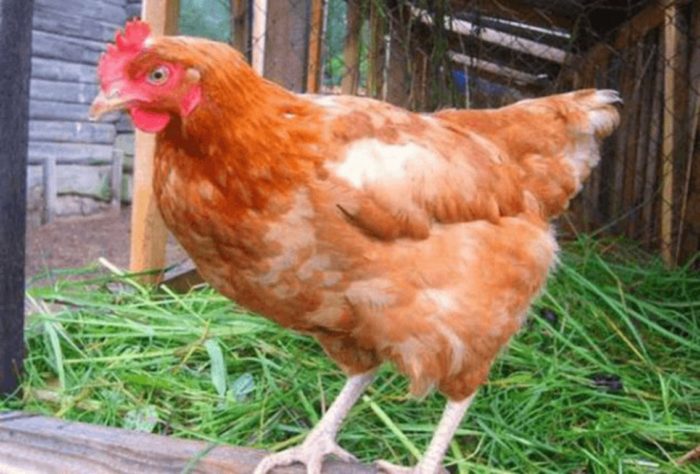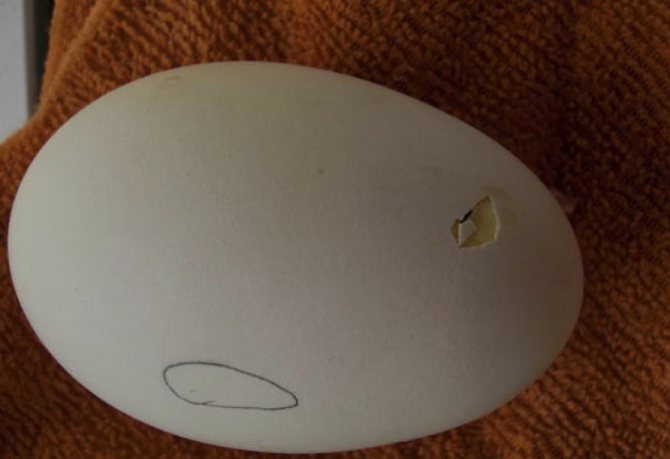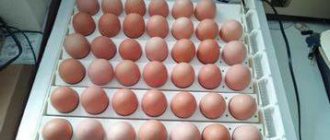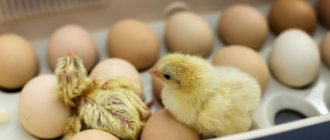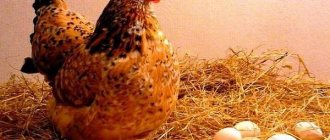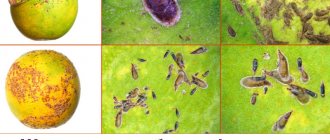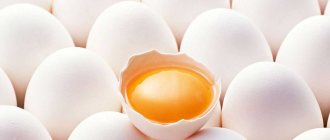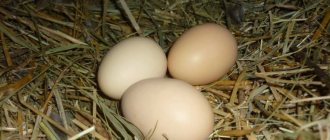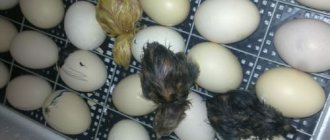Poultry »Chickens
0
3222
Article rating
The success in breeding any bird depends on how well the process of hatching young animals is staged. And this is also true for domestic chickens, regardless of whether the chicks are hatched in an incubator or under a brood hen. And in this matter, much depends on the quality of the eggs, on heredity and on the conditions of incubation. The success of hatching can be influenced by both preliminary preparations and hatching. At the same time, the effect on hatching of chickens can be not only positive, but also negative.
Hatching chicks from an egg
Incubation period
It takes 21 days from laying eggs to biting. It doesn't matter where the eggs are - under the hen or in the incubator. During this time, you should not take any action. When eggs are taken out from under the hen, they are cooled, which leads to the death of the embryo. The same goes for opening the incubator. When buying an incubator, it is better to choose an automatic model that performs all the necessary actions on its own: turns eggs, monitors the temperature and humidity level.
The development of the chick inside the shell is divided into 4 stages:
- The first one lasts for 7 days. At this time, the formation of the heart muscle and the circulatory system takes place. Also at this time, all internal organs begin to form.
- The second stage lasts from 8 to 14 days. At this time, the skeleton of the chick develops, the beak is formed.
- The third stage is only 3 days and lasts from 15 to 18 days. At this time, the motor activity of the chicks appears, they begin to make sounds. The chick squeaks, but this sound is weak.
- The last stage lasts from 19 to 21 days. During this time, the final formation of the chick takes place, the shell becomes fragile.
Often, when breeding chickens through incubation, chicks appear on the 22nd day and later. Such a deviation from the norm indicates non-observance of the required temperature regime. When the temperature is too low, the embryo develops more slowly. Chicks born late are weak. At elevated temperatures, birds are born a little earlier. If the chicks are incubated by a hen, then they appear on time.
The chicken always knows in which eggs the embryo is alive and in which it is dead. She throws an egg with a dead embryo out of the nest. To detect the presence of a live embryo inside the incubation egg, the ovoscopy procedure is performed on the 6th day after laying.
Selection of eggs
Choose the right eggs to hatch healthy chicks. It's important to make sure they come from healthy chicken. The selection should take into account the following rules:
- There should be no smell.
- The optimal weight is 50-60 g.
- Perfect shape.
- The egg should be laid no more than a week ago.
- No damage.
Eggs should not be washed and wiped, as this will damage the microflora of the shell. A transillumination device - an ovoscope will help to check them for compliance. Thanks to him, it will be possible to check if the yolk and air sac are correctly positioned. The yolk is in the middle or near the blunt edge. The air sac is located near the blunt end. You should not choose an egg in which the yolk is close to the shell or the air sac is less than the volume of a teaspoon.
Thanks to the translucence of the eggs during selection and during cultivation, it is possible to determine the pathologies of the embryo:
- stains indicate the presence of bacteria;
- lack of transparency confirms the presence of putrefactive bacteria;
- the dryness will be when the shell dries up and the presence of a pungent odor;
- blood blotches give out pathology;
- the presence of krasyuk confirms the presence of a uniform orange structure;
- if the shell is damaged during transillumination, a leak will be noticeable.
Hatching signs
There are several signs that the time for hatching is approaching. Already on the 19th day, sounds similar to a knock can be heard in the egg. They are quiet but distinct. This indicates that the chick is slowly beginning to peck at the shell. He also begins to emit a low squeak. To hear it, you should put the egg to your ear. The appearance of a voice is a good sign, which indicates that all systems and organs are fully formed. The last sign indicating that the birds will hatch in the near future is the movement of the egg, which is clearly visible on a flat surface. The formed chick moves, so the egg sways a little from side to side.
From the 19th day, the function of turning the eggs in the incubators is turned off. This is done so that the chick inside the shell takes the position from which it will be most convenient for him to hatch. Some chicks tend to be quiet until they hatch. Some, however, begin to behave especially actively 5 days before they are born. Because of this, it is better to focus not on the signs, but on the timeline.
If the egg starts to move, then the chick will hatch soon.
Embryo development
The chick formation process is divided into three stages:
- Laying of organs of the embryo, head, tissues. An active metabolism takes place, at the first stage it is important to ensure a comfortable stay.
- Lasts 15 days - the growth and development of the chick follows. Excess liquid disappears from the egg. It is important not to allow overheating during this period of time in order to avoid the birth of weakened chicks. To maintain the required level of moisture, you can spray the future brood with liquid.
- The last day before hatching. The contents of the egg - the white and the yolk, have already been consumed by the chick, so it tends to be born.For the speed of the process, you need to provide warmth in the incubator.
Hatching chicks
There are 5 stages in the process of hatching a chick, it lasts about 2.5 hours, in rare cases it takes more than 3-4 hours:
- First, a crack appears on the shell. A soft knock is heard through this crack, which indicates that the chick is pecking at the shell.
- At the next stage, a small hole appears in the shell, from which a beige beak is visible.
- Then there is an increase in the hole that appears. The hole is shaped like a belt.
- At stage 4, the eggshell breaks. This moment is considered the moment of the birth of birds.
- At the final stage of hatching, the flagellum is separated from the shell.
Small chicks hatch quickly. It is undesirable to interfere with this process. If it lasts for 6-8 hours or more, do not panic. If during all this time the chick's motor activity remains and it squeaks, then there are no problems. Often attempts to help lead to the death of newborns.
If breeding at home occurs by incubating chicks with a brooding hen, it is not required to keep the process under control. The birds independently control the process, and, if necessary, provide assistance. If the birds are bred through incubation, then since the chicks began to appear, the process is controlled. All chicks will not hatch at the same time. One chick hatches within 2 hours, while the other takes 3-4 hours.As a result of the motor activity of those chicks that have already hatched, other chicken eggs are displaced, which makes it difficult to give birth. The chicks are carefully transferred to the brooder.
It is impossible to predict the time of birth of chicks. This happens both at night and during the day.
Lohman Brown
A hatched chick cannot inherit the qualities of its parents. This is due to the peculiarity of the selection of the breed. When creating suitable conditions for the content, it will be possible to preserve only a few characteristics.
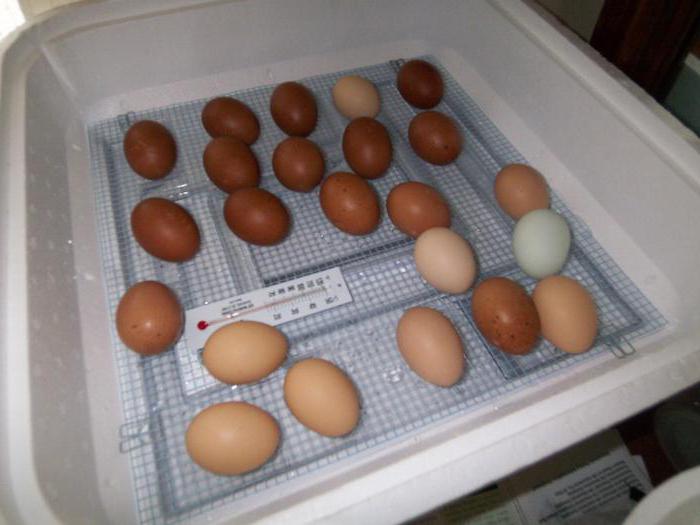
The chicken breed is in demand in Russia, as it has taken root in the country. For breeding, birds usually buy chicks or hatching eggs sold at genetic poultry farms.
Assisting with hatching
It is not advisable to rush to provide assistance to hatching chickens under a hen or in an incubator. If the chicks did not begin to hatch on time, it is forbidden to make a hole in the chicken egg and look at the state of the individual. If activity does not appear even on day 25, the embryos are dead. The reason for this lies in the non-observance of the temperature regime during incubation.
Sometimes poultry farmers begin to help the chicks free themselves from the shell. In the process of hatching, the chick's vessels are still connected to the shell. Their disconnection occurs already at the last stage. If a person begins to provide assistance, then he damages the blood vessels of a newborn bird, as a result of which it begins to lose blood. As a result of blood loss, the bird is born weak or dies.
Help is provided to chicks if they are too weak and unable to peck the shell. In this case, with gentle movements, a small hole is made in the place of the peel. If blood appears, they stop helping the chick. If, within a few hours, the chick has not yet been born, the hole is carefully enlarged. As soon as its size becomes sufficient for the chick to come out, he himself will break through the bag and break the shell. No other action can be taken.
You cannot help a brooding hen. She instinctively understands what to do, and, if necessary, will help much better than a person.
Inspection of chicks
Egg breeds should be examined after 6 hours, and meat breeds after 10. Chicks have the following characteristics:
- closure of the umbilical cord, lack of blood;
- shine and softness;
- lack of cloudiness of the eyes;
- hard beak;
- the wings are attached to the body;
- activity, reaction to noise.
If it is important to find out the sex of the bird, you can use simple methods:
- When the chick is taken by the scruff of the neck or legs, the cockerels hang calmly, and the hens raise their legs or pull their heads.
- During incubation, hens appear first.
- In chickens, there is an alternation of long feathers with short ones, and in a rooster, all are the same.
First steps
After all the chicks have hatched, they are dried. To do this, use a brooder or a special garden, which is easy to do at home. Newborns need warmth for the first 5-10 days, which is why a brooder or kindergarten is equipped with a lamp. Better to use a red lamp. They place it at such a distance that the birds do not get burned. The temperature is maintained at 30 ° C.
The egg contains all the nutrients that the chicks need, so they are in no hurry to feed them. After the fluff has dried, give the first meal. Appetite in newborns is sometimes good and sometimes absent. It is forbidden to give them food by force. It is better to offer food in 30-40 minutes. Chopped yolk or corn grits work well for the first feed. In order for the chicks to develop properly, the first feeding is carried out no later than 12 hours after hatching. Lack of food during the first 12 hours after birth will have a negative effect on the further development of the chick. If he has not received food within 16-18 hours, then, most likely, he will die. Starting from day 2, cottage cheese is added to the diet, mashings are made from small cereals. At home, they create a starter compound feed.In the regulatory documents, day by day it is prescribed what the temperature and humidity of the air in the chicken coop should be and what the feed rate should be.
Egg setting procedure
Hatching of chicks will take place without complications if properly prepared. Place the eggs in a warm room before laying. The temperature of the eggs should be 25 degrees. The incubator must be cleaned and disinfected during preparation for laying eggs. It is advisable to check the incubation mode beforehand. Before laying, the temperature should be 36 degrees.
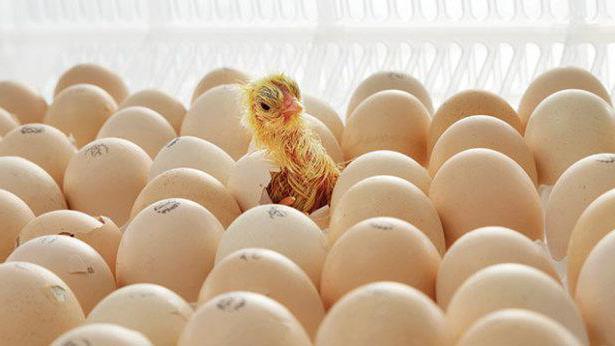

Eggs are placed with the blunt end up. If the device is automatic, then there is no need to control the pan tilt, temperature and humidity. With the use of a mechanical apparatus, these characteristics must be monitored very carefully. The eggs are laid horizontally, and then the trays must be rotated 180 degrees. It is advisable to bookmark in the evening. After 4 hours, you need to lay the middle ones, and when 4 hours have passed - small ones. Then the brood will be uniform.
Choice of equipment for incubation
The incubation equipment warms the eggs for 21 days - this allows you to replace the hen. Therefore, the incubator must meet the following criteria:
- function of temperature regulation and protection against sudden changes;
- creation of optimal air humidity;
- air exchange;
- self-inclusion;
- function of flipping trays.
Multifunctional incubation equipment is used commercially and is expensive. Novice farmers do not always manage to purchase it, therefore, mechanical equipment is used for such purposes.
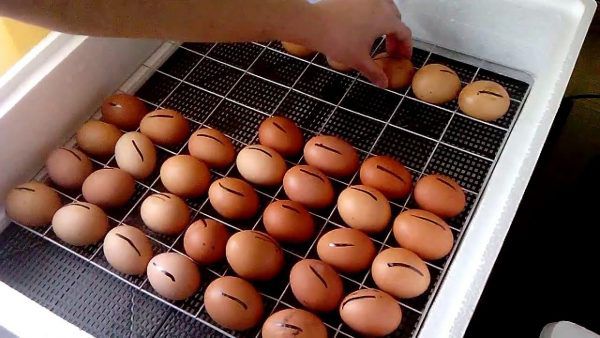

Mechanical incubator
Incubators do an excellent job of laying hens, increasing productivity and reducing your labor costs several times. One of these helpers for farmers is incubator "Cinderella".
Moments before birth
To determine how to help your chicks survive, you need to understand how they hatch:
| Stages | Signs |
| 1. | A crack is outlined, a squeak is heard. |
| 2. | When brought to the ear, you can hear the chick scratching, knocking with its beak. |
| 3. | During the day, the crack grows. |
| 4. | A hole appears, a beak can be seen through it. |
| 5. | If the chick is healthy, then his efforts are enough to break his egg in half and go outside, there is no need to help hatch. |
How to free chicks
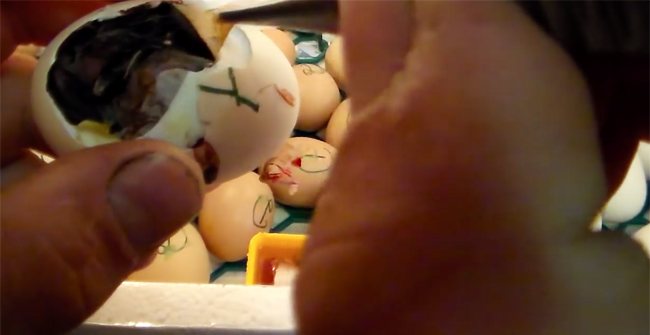

Sometimes you have to help to remove the shell half, or even completely, so that the chick can hatch. If the film is intact, leave a hole for the beak and return to the incubator. In case of a damaged form, when the blood vessels are affected, the blood must be removed with a cotton swab moistened with a weak solution of potassium permanganate in order to prevent rotting and infection of the rest of the chickens. A drop of blood in the form of beads is not terrible, and in case of severe bleeding, you will have to sacrifice one unviable chick in order to preserve the health of others.
Removing the shell is inconvenient at the very beginning. But when it is already possible to penetrate the hole with the index finger, it is easier to help hatch. It is necessary, by pressing on the film, to move it slightly from the surface of the shell and peel off in pieces carefully and slowly.
It rarely happens that twin chickens are born. They are much weaker and usually stay in the incubator longer. However, it must be borne in mind that after 25 days, the chickens are unlikely to be alive.
Is it possible to do without an incubator and chicken
It is permissible to remove a chicken from an egg without a brooding hen and an incubator by equipping an imitation of an apparatus for artificial hatching. To do this, you need the following:
- cardboard box (50 x 40 x 50 cm);
- light bulb;
- thermometer;
- extension;
- glass (30 x 50 cm);
- piece of cloth (necessarily soft);
- sheet of cardboard (30 x 50 cm);
- container with water about 4 cm high.
The creation process consists of several steps:
- put fabric on the bottom of the box, place water and a thermometer there on opposite sides from each other;
- make a slot for the bulb holder in a sheet of cardboard, then insert it and connect to the mains;
- put a sheet of cardboard on top of the box, having covered it up to half, on the other side - a sheet of glass;
- heat the air in the box to a temperature of 37 ° С;
- put eggs in the resulting structure and turn over at least three times a day;
- hatching can be observed in about 21 days, 3 days before this event, the temperature in the box must be raised to 38 ° C.
Important! Instances from which chicks did not appear within 520 hours are subject to rejection.
In order not to get confused when turning the eggs, it is recommended to make marks on the shell.


